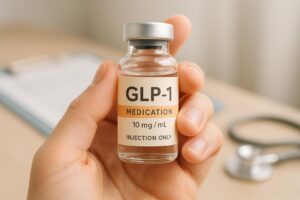Does Fiber Increase GLP-1? Exploring the Connection

Introduction
Have you ever wondered why some foods seem to keep you feeling full longer? It turns out, the answer might lie in fiber. Recent studies have highlighted fiber’s role in increasing levels of glucagon-like peptide-1 (GLP-1), a hormone that plays a significant part in regulating appetite and blood sugar levels. This fascinating connection raises an important question: Does fiber increase GLP-1?
In a world where obesity and diabetes are on the rise, understanding the mechanisms behind appetite regulation and metabolism is more crucial than ever. GLP-1 is a key player in this arena, influencing how our bodies process food and manage hunger. As we explore this topic, we will delve into the science behind fiber, GLP-1, and their interactions, providing insights into how dietary choices can potentially enhance our health.
By the end of this blog post, you will gain a deeper understanding of the relationship between fiber intake and GLP-1 levels, the types of fiber that may be most beneficial, and practical tips for incorporating these foods into your diet. Together, we’ll uncover how these dietary choices can contribute to a healthier lifestyle, aligning with our commitment at TrimRx to help individuals embrace healthier living through science and empathy.
What is GLP-1?
GLP-1 is a hormone produced in the gastrointestinal tract, particularly by the L-cells in the small intestine. It plays a vital role in glucose metabolism and appetite regulation. When we eat, GLP-1 is secreted in response to nutrients, promoting insulin secretion from the pancreas and inhibiting glucagon release, which helps lower blood sugar levels. Additionally, GLP-1 slows gastric emptying, enhancing feelings of fullness after meals.
The significance of GLP-1 extends beyond just glucose management; it also has implications for weight management. By influencing appetite control, it helps individuals feel satisfied after consuming food, potentially reducing the urge to snack or overeat. This has led to increased interest in GLP-1 as a target for obesity and diabetes treatment, with medications that mimic its effects gaining popularity in recent years.
The Importance of GLP-1 in Weight Management
- Appetite Regulation: GLP-1 reduces appetite by acting on the brain, signaling satiety.
- Insulin Secretion: It stimulates insulin release in response to meals, aiding in glucose control.
- Slowed Digestion: By delaying gastric emptying, GLP-1 prolongs the feeling of fullness.
These functions underscore the importance of GLP-1 not just in managing diabetes but also in supporting effective weight loss strategies. As we seek to understand how dietary choices can influence GLP-1 levels, fiber emerges as a key player.
The Role of Fiber in Diet
Fiber is a type of carbohydrate that the body cannot digest. While most carbohydrates break down into sugar molecules, fiber cannot be broken down into sugar and instead passes through the digestive system relatively intact. This characteristic makes fiber essential for digestive health, but it also plays a pivotal role in regulating blood sugar levels and appetite.
Types of Fiber
There are two main types of dietary fiber:
- Soluble Fiber: This type dissolves in water and forms a gel-like substance in the digestive tract. It can help lower blood sugar levels and cholesterol. Sources include oats, beans, lentils, apples, and citrus fruits.
- Insoluble Fiber: This type does not dissolve in water and adds bulk to stool, helping food pass through the digestive tract. Sources include whole grains, nuts, and vegetables.
Both types of fiber are crucial for maintaining a healthy digestive system, but they may also influence GLP-1 levels differently.
How Fiber Affects GLP-1 Secretion
Research indicates that dietary fiber can stimulate the release of GLP-1. When fiber is fermented in the colon by gut bacteria, it produces short-chain fatty acids (SCFAs), which have been shown to enhance GLP-1 secretion. Here’s how this process works:
- Fermentation: Certain fibers are fermented by gut bacteria, producing SCFAs like acetate, propionate, and butyrate.
- GLP-1 Release: SCFAs stimulate the L-cells in the intestines to produce and release GLP-1.
- Appetite Regulation: The increase in GLP-1 helps signal the brain to reduce hunger, leading to lower calorie intake.
Studies have shown that diets rich in fermentable fibers can significantly increase GLP-1 levels, contributing to improved appetite regulation and better glycemic control.
The Science Behind Fiber and GLP-1
Recent Research Findings
- Beta-Glucan and GLP-1: Studies have found that beta-glucan, a soluble fiber found in oats and barley, can boost GLP-1 levels significantly. This type of fiber not only promotes satiety but may also improve insulin sensitivity.
- Fermentable Fibers: Research indicates that fermentable fibers, such as those found in beans, legumes, and whole grains, enhance GLP-1 secretion more effectively than non-fermentable fibers.
- Dietary Patterns: Diets that emphasize high-fiber foods, particularly those rich in soluble fiber, are associated with higher GLP-1 levels and improved metabolic outcomes.
These findings highlight the potential of fiber as a dietary strategy to enhance GLP-1 secretion, providing a natural way to support weight management and metabolic health.
Practical Implications
Incorporating fiber-rich foods into our diets can be a simple yet effective strategy for increasing GLP-1 levels and improving overall health. Here are some practical tips:
- Choose Whole Grains: Opt for whole grains like oats, barley, and brown rice over refined grains. These are rich in soluble fiber, which can enhance GLP-1 secretion.
- Add Legumes: Beans, lentils, and peas are excellent sources of both soluble and insoluble fibers. They can be easily added to soups, salads, or as side dishes.
- Include Fruits and Vegetables: Fruits like apples, pears, and berries, along with vegetables such as broccoli and Brussels sprouts, are not only rich in fiber but also provide essential vitamins and minerals.
By making these dietary adjustments, we can foster a healthier gut environment, promote GLP-1 secretion, and support our weight loss journeys.
TrimRx’s Commitment to Personalized Care
At TrimRx, we understand that weight loss is a unique journey for each individual. Our approach combines cutting-edge telehealth innovations with personalized weight loss solutions that are medically supervised to ensure safety and effectiveness. We believe that the path to sustainable weight loss should be achieved through science, empathy, and a transparent approach.
Our personalized weight loss programs include comprehensive services such as doctor consultations, medication, lab work, unlimited support, and shipping—without any hidden fees. We are dedicated to providing a supportive environment where individuals can embrace healthier lifestyles.
Taking the First Step
If you’re curious about how personalized weight loss solutions can help you, we encourage you to take our free assessment quiz. This quiz will help determine your eligibility for our prescription weight loss medications, allowing us to create a treatment plan tailored specifically to you. You can access the quiz here: Take the Free Assessment Quiz.
Additionally, we offer quick-access supplements that can support your weight loss journey. Our GLP-1 Daily Support and Weight Loss Boost supplements are designed to complement your dietary efforts, providing you with the extra support you need. You can learn more about these products here: GLP-1 Daily Support and Weight Loss Boost.
Conclusion
The relationship between fiber and GLP-1 is an exciting area of research that underscores the importance of dietary choices in managing weight and metabolic health. Increasing fiber intake, particularly through soluble and fermentable fibers, can enhance GLP-1 secretion and contribute to improved appetite regulation and glycemic control.
As we continue to explore the science of nutrition and its impact on our health, it’s essential to recognize the role that fiber can play in our diets. By incorporating fiber-rich foods into our meals, we can foster a healthier gut and support our body’s natural processes.
At TrimRx, we are committed to helping individuals achieve their weight loss goals through personalized, medically supervised care. Together, we can embrace healthier lifestyles and work towards sustainable weight management.
FAQ
How much fiber should I consume daily?
The recommended daily intake of fiber is about 25 grams for women and 38 grams for men. However, individual needs may vary based on age, activity level, and health status.
What are some high-fiber foods to include in my diet?
Foods rich in fiber include fruits (e.g., apples, pears, berries), vegetables (e.g., broccoli, carrots), whole grains (e.g., oats, barley), legumes (e.g., beans, lentils), and nuts and seeds.
Can I increase GLP-1 levels without taking supplements?
Yes, dietary choices can naturally enhance GLP-1 levels. Incorporating more fiber-rich foods, particularly those that are fermentable, can stimulate GLP-1 secretion and support appetite regulation.
How do GLP-1 medications work?
GLP-1 medications mimic the effects of the natural GLP-1 hormone, promoting insulin secretion, reducing appetite, and slowing gastric emptying, which can lead to weight loss.
Is it safe to increase fiber intake suddenly?
It’s best to gradually increase fiber intake to allow your digestive system to adjust. Sudden increases may lead to bloating or digestive discomfort. Drinking plenty of water can also help ease this transition.
Incorporating fiber into your diet not only supports GLP-1 levels but also contributes to overall health and well-being. With the right approach and support, achieving your weight loss goals is attainable.

Transforming Lives, One Step at a Time
Keep reading
Tracking Progress With GLP-1: What To Measure
Learn which metrics to track on GLP‑1 therapy—weight, waist, blood sugar, lipids, side effects, and non‑scale wins—and how often to monitor them.
Fatigue Solutions for Ozempic and Wegovy Users
Hydration, protein-rich meals, light activity, and better sleep can reduce medication-related fatigue and help maintain energy during weight-loss treatment.
GLP-1 Medication Side Effect Checker
Worried about GLP-1 medication side effects? Use our free checker for Semaglutide, Liraglutide, and more to learn what to expect and stay informed!



